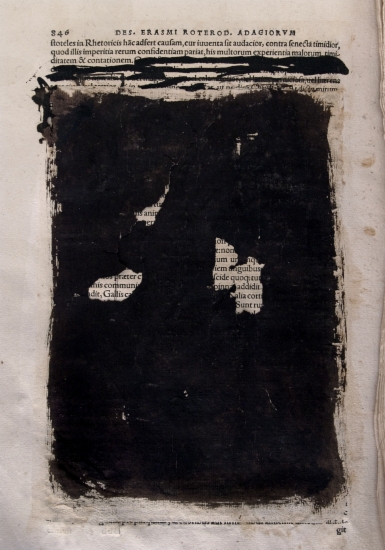Photography ‘Nobel’ Joan Fontcuberta explores the aesthetics of censored texts
The 2013 winner of the prestigious Hasselblad Foundation Photography Award – which is like the Nobel Prize in this field – has been exploring the “aesthetics of censorship” in texts dating from the 16th to the 19th century. The “violent interventions” of censors are revealed in ‘Deletrix’, a series of photographs taken by Catalan Joan Fontcuberta and exhibited at the Santa Mònica Arts Centre of Barcelona. In addition, Fontcuberta also releases a book displaying the artist’s 6 years of delving into archives and libraries. Fonctuberta did not wish to solely condemn censorship and defend freedom of expression. He also observed that the “violent” and “visceral energy” expressed in these human interventions influenced some contemporary works of art. And therefore, the photographer sought to explore the relationship between art and censorship.

Barcelona (ACN).- On the Day of the Imprisoned Writer, the Santa Mònica Arts Centre of Barcelona will unveil Catalan photographer Joan Fontcuberta’s latest project, entitled ‘Deletrix’. The 2013 winner of the prestigious Hasselblad Foundation Photography Award – which is like the Nobel Prize in this field – will present an exhibition and a book of photographs exploring “the aesthetics” of censorship in historical texts. After 6 years of venturing into European and American libraries and archives, Fontcuberta reveals a series of “violent” interventions of censorship on ancient texts. Pages cut, burned or covered with thick layers of ink, all convey the brutality of censorship throughout history. However, Fontcuberta did not wish to solely condemn censorship, as an obstacle to freedom of expression. He also observed that the “violent” and “visceral energy” detected in these interventions influenced some contemporary works of art. And so he sought to explore the connections between these “expressions of humanity” and contemporary art, explaining that such traces had “influenced certain current artistic practices”.
Fontcuberta was awarded the 2013 Hasselblad Award for being “one of the most inventive contemporary photographers, with over 30- years’ achievement of constantly investigating and questioning the photographic medium”, according to the jury of the world’s most prestigious photography prize. In ‘Deletrix’, the Catalan photographer– seeks to explore the connections between artistic expression and censorship. He believes that the “violent” traces and gestures of censors take a “visual resonance” when they were reinterpreted for instance in “the works of Fontana, Tàpies, or Pollock”. Such stains and other traces marked the pages of works by Erasmus of Rotterdam, Antoine Gallien, Jean -Baptiste Lully and Sebastian Munster. Visitors can see these various marks in the exhibition at the Santa Mònica Arts Centre as well as in Fontcuberta’s book retracing the full complexity of his research work in the libraries of Europe and America during 6 years.
Defending freedom of expression
The ‘Deletrix’ exhibition is organized as part of the activities promoted by the Catalan PEN (Poets, Essayists and Novelists) to celebrate the Day of the Imprisoned Writer. The PEN is dedicated to warning our modern societies against the violation of freedom of expression by introducing the point of view of contemporary Catalan artists like Fontcuberta who have specifically delved into the subject. The partnership between the PEN and Fontcuberta began in 2011 when one of his photographs was used in the PEN’s poster to commemorate the Day of the Imprisoned Writer that year.
Fontcuberta on censorship in modern societies
When Fontcuberta was asked by the ACN about the current state of censorship, the photographer expressed his conviction it had not disappeared but only evolved. The prestigious photographer described the current censorship as “an aesthetics of invisibility, malevolent in its approach, and difficult to detect” that had more to do with concealing information or directly pressuring the informants so they would avoid certain topics”.